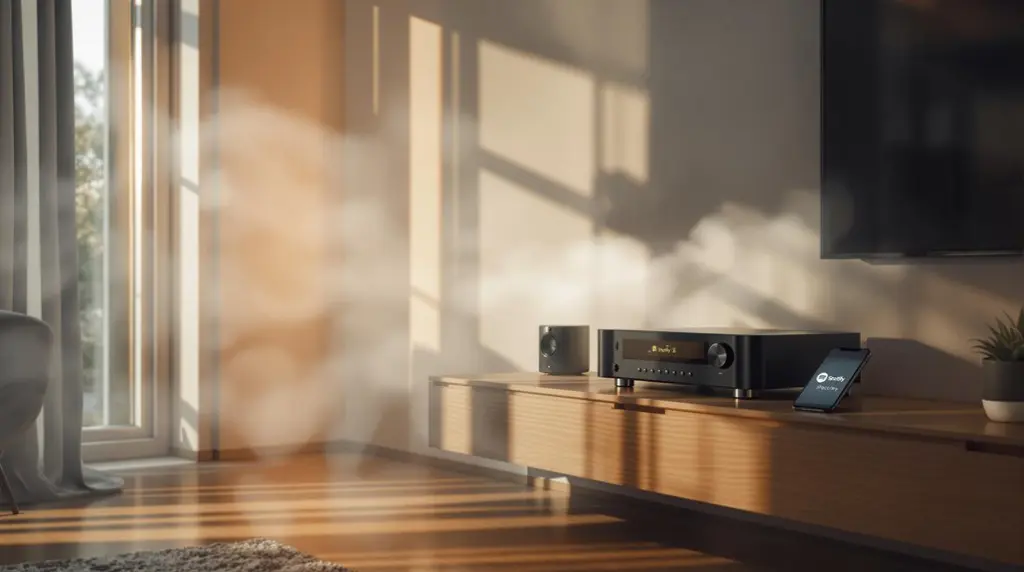To fix Serato tracks playing backwards, begin by ensuring keyboard shortcuts, like ‘Q’ and ‘A’, are not mistakenly activated. Verify RCA connections, ensuring the red and white cables are correctly aligned to respective inputs and outputs, checking for damage. Confirm that the DVS setup has correct left and right phono input alignment to avoid signal misinterpretation. Additionally, check that deck direction settings are properly configured and update controller firmware regularly to prevent conflicts. For more complex solutions, explore Serato’s documentation and community forums, where experienced users share tips and troubleshooting techniques.
Key Takeaways
- Check and correct keyboard shortcuts for deck direction, specifically ‘Q’ for left deck and ‘A’ for right deck.
- Inspect RCA connections for proper alignment and damage, ensuring red and white cables are correctly placed.
- Verify DVS setup with correct phono input connections to prevent reverse playback.
- Adjust audio configurations, ensuring deck direction settings and firmware are up-to-date.
- Utilize Serato support resources and community forums for troubleshooting advice and practical fixes.
Understanding Reverse Playback
Reverse playback in Serato DJ is a phenomenon that, while infrequent, can disrupt a seamless DJ set. Understanding reverse playback causes is vital for troubleshooting and preventing unexpected reversals of your tracks. This issue primarily occurs when the direction keys for one of the decks are accidentally pressed, resulting in waveforms scrolling in the opposite direction. The toggle mechanism is controlled by pressing the ‘Q’ key for the left deck and the ‘A’ key for the right deck.
Consequently, unintended key presses can lead to reverse playback scenarios, a problem often forgotten due to its rare occurrence, approximately every 18 months.
To mitigate reverse playback, confirm that your audio playback scenarios are correctly configured. Proper audio input setup is paramount, as incorrect configurations can inadvertently trigger reverse playback.
DVS users must verify their left and right phono inputs are accurately connected, as improper connections can mimic reverse playback issues. By maintaining vigilance over key assignments and verifying audio setups, DJs can minimize the likelihood of encountering this disruptive playback behavior.
Regular checks and familiarity with your Serato DJ setup can help maintain a glitch-free performance, preserving the intended flow of your DJ set.
Checking Keyboard Shortcuts
To guarantee seamless DJ performances, verifying your keyboard shortcuts in Serato DJ is essential for preventing and resolving playback issues such as tracks playing in reverse. Utilizing keyboard shortcuts not only enhances performance efficiency but also provides significant shortcut benefits by allowing DJs to execute commands rapidly. For instance, toggling playback direction can be swiftly achieved by pressing the ‘Q’ key for the left deck and the ‘A’ key for the right deck, effectively correcting any accidental reverse playback.
In addition to these specific keys, familiarizing yourself with other important shortcuts is vital to streamline your mixing workflow. The table below outlines some of the key shortcuts that can improve your setup:
| Function | Left Deck Key | Right Deck Key |
|---|---|---|
| Toggle Reverse | Q | A |
| Play | W | S |
| Stop | E | D |
| Cue | R | F |
| Sync | T | G |
Exploring the help menu in Serato reveals an extensive list of shortcuts, enabling DJs to master key functions quickly. Regular practice with these shortcuts will not only diminish playback issues but also bolster your confidence during live performances, ensuring a more efficient and effective DJing experience.
Inspecting RCA Connections
To address the issue of tracks playing backwards in Serato, begin by ensuring the RCA connections are correctly placed, with red and white cables properly aligned with their respective inputs and outputs.
Perform a visual inspection of each RCA cable for any signs of damage or misalignment that could lead to playback anomalies.
Additionally, swapping RCA connections between devices can help isolate whether the problem arises from improper setup or faulty cabling.
Correct RCA Placement
Guaranteeing the correct placement of RCA connections is vital for preventing tracks from playing backwards in Serato. Proper RCA color coding and cable maintenance are fundamental to achieving accurate audio playback.
Begin by confirming that the red and white RCA cables are connected to their respective outputs and inputs. This alignment is essential, as incorrect connections can lead to reverse audio playback.
When dealing with RCA cables, consider the following technical guidelines:
- RCA Color Coding: Utilize color-coded cables to match the corresponding ports—red for right audio and white for left audio.
- Channel Consistency: Double-check that the left RCA cable is connected to the left channel and the right cable to the right channel to maintain stereo integrity.
- Cable Maintenance: Regularly inspect cables for wear and tear; damaged cables can disrupt the audio signal.
- Troubleshooting Swap: If issues persist, swap RCA connections between turntables and the Rane device to isolate the problem.
These steps aid in maintaining consistent audio performance and preventing playback issues.
Visual Cable Inspection
Proper RCA placement is a fundamental step in rectifying Serato playback issues, yet visual cable inspection can further identify and resolve persistent problems. Begin by confirming that the red and white RCA cables are connected correctly: the red cable should be plugged into the right channel and the white into the left. This simple step can prevent reverse playback issues.
However, if problems persist, a thorough visual inspection is essential. First, examine the RCA plugs for any signs of wear, damage, or misalignment. Identifying wear early can prevent audio playback problems and extend the life of your cables. Look for frayed wires, bent connectors, or corrosion, which may indicate the need for replacement.
Securely plug the RCA cables into both the turntables or CD players and the Rane device. Loose connections can cause playback irregularities, so confirm a snug fit. Additionally, inspect the wiring in the turntables or headshells. Reversed wiring can result in tracks playing backward, even if RCA connections are correct.
As part of cable maintenance tips, utilizing color-coded RCA cables can simplify setup and reduce connection errors, confirming seamless audio performance.
Verifying DVS Setup
A vital step in resolving playback issues in Serato DJ is verifying the DVS setup, as improper connections can result in tracks playing backwards. To address this, start by confirming that the left and right phono inputs are connected correctly. Miswiring these inputs is a common cause of reverse playback.
Understanding audio interfaces can greatly assist in this process, as correct configuration is essential for proper operation. Additionally, verify that all cables and connections are in good condition to prevent audio signal interference or loss.
Utilize DVS calibration techniques to guarantee that the system accurately interprets the timecode signal:
- Secure RCA connections: Double-check that RCA cables are firmly connected between turntables or CD players and the Rane device.
- Swap RCA connections: Test playback by swapping RCA cables between turntables and the Rane device, identifying any potential wiring issues.
- Consult documentation: Refer to the manufacturer’s guidelines for specific connection instructions, confirming your DVS setup is properly configured.
- Verify settings: Confirm that audio interface settings in Serato DJ are correctly set to prevent misconfigured DVS setups from causing playback problems.
Adjusting Audio Configurations
To rectify Serato tracks playing backwards, start by confirming the RCA cables are properly connected, paying close attention to the color-coded inputs to avoid reversing the channels.
Next, verify that the deck direction settings on the hardware align with the intended playback direction, as misconfigured settings can lead to reverse playback.
It is also important to regularly update controller firmware to prevent potential compatibility issues that might affect audio playback.
Additionally, inspect the phono input configuration to confirm compatibility with the turntable setup, as incorrect settings may contribute to the issue.
Correct RCA Cable Setup
Frequently, guaranteeing a seamless audio playback experience in Serato involves meticulous attention to the RCA cable setup. The integrity of the audio signal is paramount, and this begins with the proper configuration of RCA cable types. The red RCA cable must be connected to the right channel, while the white RCA cable should align with the left channel. This fundamental setup guarantees that the audio playback direction is correct and prevents tracks from inadvertently playing backward.
Secure fittings are critical; loose connections can disrupt audio signal integrity and lead to unexpected reverse playback. It’s essential to verify that cables are not swapped, as incorrect placement can cause confusion in audio output.
Regular testing of the configuration is advised, running a playback each time adjustments are made to confirm functionality.
To streamline the setup process and avoid misconfigurations, employ color-coded RCA cables. This visual aid simplifies identification and connection, reducing errors that could result in reverse playback.
- Guarantee red RCA is on the right and white on the left for correct channel alignment.
- Inspect RCA connections for secure fittings.
- Confirm cables are not swapped to maintain proper audio output.
- Use color-coded RCA cables for easy setup.
Verify Deck Direction Settings
Verifying proper RCA cable setup is vital, yet issues may still arise if deck direction settings are overlooked. When tracks in Serato DJ play in reverse, it’s important to check whether the deck direction settings have been inadvertently altered.
The reverse playback feature can be unintentionally triggered by pressing specific keys: Q for the left deck and A for the right deck. This can lead to unexpected playback issues that may disrupt your audio performance.
To address this, start by confirming that these keyboard shortcuts have not been activated. Familiarize yourself with Serato’s keyboard shortcuts related to playback direction to manage these settings efficiently.
If you discover that the reverse playback mode is active, simply toggle it off using the same keys to restore normal playback.
Additionally, review your audio configurations to confirm that any changes made are intentional and correct. Persistent playback issues may necessitate consulting Serato’s support documentation for guidance tailored to your specific deck settings.
Check Phono Input Configuration
Misconfigured phono inputs are a common culprit when tracks in Serato DJ play backward. To guarantee that your audio signal is correctly configured, start by verifying the connections of your phono inputs. Incorrect wiring can greatly affect playback, leading to unexpected reverse audio signals. Addressing this issue involves a series of straightforward checks and adjustments.
- Confirm RCA Cable Placement: Verify the red and white RCA cables are correctly placed. Swapping these can often resolve backward playback issues by aligning the audio signal correctly.
- Inspect Turntable Connections: Check the connections of your turntables or headshells. Reversed connections can lead to unexpected output, causing tracks to play in reverse.
- Test Alternate Configurations: Regularly test alternate cable configurations to identify any wiring issues. This can provide insight into whether a specific setup causes the reverse playback problem.
- Familiarize with Input Setup: Understanding the audio input setup process can prevent misconfigurations. A clear knowledge of this can avert future playback complications.
Troubleshooting Serato DJ
In troubleshooting Serato DJ, one common issue that users encounter is tracks playing backwards, which can often be resolved through a series of methodical checks.
Start by verifying the track selection and ascertain that audio effects are not inadvertently causing the reverse playback. Familiarity with the DJ controller layout can also help in quickly identifying if there is a misconfiguration causing the issue. It is vital to check the left and right deck direction keys—press ‘Q’ for the left deck and ‘A’ for the right deck—to toggle playback direction. Misconfigured keys can easily lead to unintended results.
Next, inspect the RCA cables for correct connections; improper alignment can cause tracks to play in reverse. Visual inspection should confirm that all cables are properly inserted and aligned.
For Digital Vinyl System (DVS) setups, check that the left and right phono inputs are configured correctly, as any misconfiguration can result in playback anomalies.
Utilize the help menu within Serato DJ to access an extensive list of keyboard shortcuts, which can simplify troubleshooting and improve efficiency in adjusting playback settings.
If issues continue, meticulously document all troubleshooting steps undertaken. This log will be invaluable should you need to seek assistance from community forums or Serato DJ support resources for further guidance.
Exploring Waveform Controls
Waveform controls in Serato DJ are critical for achieving precise and seamless mixing. These controls allow DJs to utilize waveform customization for enhanced visual mixing, guaranteeing tracks are perfectly aligned.
By zooming in and out on the main waveform using the + or – keys, DJs can gain a clearer view of the track’s structure and shifts, which is essential for precision. Adjusting the brake time via settings is another technique, offering creative control over the tape stop effect, thereby influencing how tracks conclude.
Key actions to take into account for maximizing waveform controls include:
- Zooming: Use the + or – keys to adjust the waveform view, providing enhanced visibility for mixing shifts.
- Brake Time Adjustment: Modify settings to control tape stop effects, offering creative track halt options.
- Waveform Visibility: Guarantee peak visibility by adjusting DJ Preferences, aiding in track identification and selection.
- Color Customization: Apply different colors to waveforms to easily distinguish tracks, boosting mixing efficiency.
Real-time access to waveforms is paramount for monitoring playback and making immediate adjustments.
Utilizing Support Resources
When grappling with playback issues like tracks playing backwards in Serato DJ, tapping into the wealth of support resources available can markedly streamline the troubleshooting process.
Begin by referencing the official Serato documentation, which provides thorough explanations and step-by-step guides on resolving playback issues. This documentation can be indispensable in understanding the intricacies of playback settings and identifying misconfigurations that may lead to tracks playing backwards.
Community forums serve as another crucial resource, offering a platform where users discuss their experiences, share solutions, and provide insights into common playback problems. Engaging with these user experiences can reveal practical fixes and alternative approaches that may not be immediately apparent.
Online tutorials, such as those offered in the Serato Made Easy course, provide structured learning opportunities, enabling users to deepen their knowledge of the software. Mastering such tutorials can preemptively mitigate playback issues by enhancing users’ overall command of Serato DJ.
Additionally, subscribing to resources like the Digital DJ Tips newsletter guarantees users remain informed about the latest updates, tutorials, and techniques.
Engaging With the Community
Beyond leveraging official documentation and structured tutorials, engaging with the Serato user community offers another layer of support for resolving playback anomalies, such as tracks playing backwards. This community engagement opens avenues for obtaining community insights and sharing user experiences, which can be invaluable in troubleshooting these issues. Fellow DJs often provide practical tips and innovative solutions that may not be covered in official resources.
Consider these approaches to maximize benefits from community interaction:
- Join Forums: Engage in discussions on Serato community forums to uncover new techniques and solutions to common problems like tracks playing backwards.
- Social Media Channels: Follow Serato’s official social media channels, especially Instagram, for updates and practical hints about software features and improvements.
- Share Experiences: Contribute your own troubleshooting successes and insights to enrich the collective knowledge, helping others who might face similar challenges.
- Leverage Digital DJ Tips Community: With over 150,000 members, this network provides a wealth of support and camaraderie, enhancing your DJ skills and problem-solving capabilities.
Frequently Asked Questions
How to Fix Serato Playing Backwards?
To resolve track playback issues in Serato, verify the Serato settings and guarantee RCA cables are correctly connected. Toggle playback direction using ‘Q’ or ‘A’ keys. Regularly check your DVS system configuration for peak performance.
How to Reverse the Track on Serato?
To reverse a track in Serato, utilize track manipulation techniques by pressing and holding the Control or Command key while clicking Play. Enhance audio editing capabilities by familiarizing yourself with keyboard shortcuts, ensuring precise control during troubleshooting scenarios.
How Do I Reset My Serato Plays?
To reset your Serato plays, access your Serato settings and navigate to audio preferences. Verify track analysis is updated to prevent playback issues. Regularly review configurations and utilize keyboard shortcuts for efficient troubleshooting and ideal performance.
How Do I Reset My Serato Sync?
To reset Serato sync, toggle the Sync button off and on to restore default sync settings. If sync issues persist, restart Serato DJ, confirm decks match BPM, and verify control vinyl calibration for DVS users.
Conclusion
In addressing issues of reverse playback in Serato, it is essential to investigate potential causes methodically, including keyboard shortcut activation, RCA connection integrity, and Digital Vinyl System (DVS) setup accuracy. Additionally, adjustments to audio configurations, a thorough troubleshooting of the Serato DJ software, and an exploration of waveform controls are recommended. Engaging with available support resources and the broader community can provide valuable insights and solutions, ensuring peak functionality and user experience.




